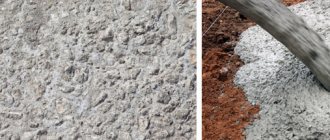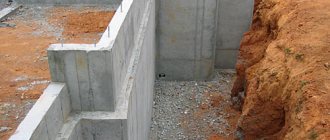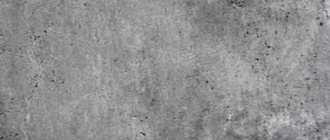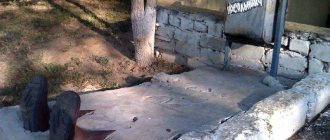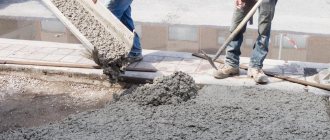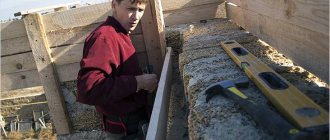Lightweight concrete M75 is popular among landscape designers, sculptors and builders. This building material has low strength and is well suited for creating borders and garden paths, temporary installations, and for the construction of small buildings. But it also has several disadvantages, due to which it is not used for the construction of more serious objects. Low frost resistance and water resistance, rapid deformation and a rather low strength index (only no more than 65 kg/cm2) do not inspire confidence in this class.
The main advantage of M75 concrete is its slow drying, which makes it easy to correct possible mistakes or completely change the shape of the structure.
Brand of cement mixture M75
Although the mortar is inferior in strength, moisture and frost resistance to heavier analogues, it also has a number of its advantages: the M75 cement mortar has a low cost, and it is also slowly cemented, which helps to quickly correct detected flaws and shortcomings.
To ensure that the result meets your expectations, order building materials from manufacturers responsible for product quality. These include the RBU network in the Moscow region, where they will help you arrange the delivery of masonry mixture to any locality in the region.
Cement mortar for foundation
For ease of mixing the mortar, a concrete mixer is used. The classic recipe for the mixture initially requires filling with water. You should proceed from the amount of cement: 1 bucket of cement to 1 bucket of water, as a rule, these components are proportional. To obtain the required consistency of the solution, water must be poured in gradually. If sand is used while it is wet, the amount of water should be reduced.
Professional masons advise adding liquid soap to water when preparing the solution to give it greater elasticity. Water with soap has the greatest fluidity, unlike ordinary water. This mixture will better wet the filler and poured surfaces. Its ability to fill small pores will reduce the number of voids and cavities. Strength and elasticity will increase significantly. Before mixing soapy water with the solution, soap and water must be combined.
As soon as the liquid soap has dissolved and foamed, you can add about half of the prepared sand. After this, cement should be added in full. Next, all components are mixed for about 5 minutes and the rest of the sand is poured. If the solution is not thick enough, add a small amount of water. How do you know the correct consistency of cement mortar? The solution should resemble sour cream, and if you draw something on it, the drawing should leave its outline.
4.8 / 5 ( 6 votes)
Where can I use M75 cement mixture
This material is not suitable for the construction of load-bearing or supporting structures. But he excels in gardening art, landscape design and private construction. Masonry mixture M75 can be used in the following works:
- repair of areas not subject to heavy loads;
- preparation of the underlying cushion for sidewalks and curbs;
- soil stabilization before pouring the foundation;
- creation of floor screeds and roof screeds for certain types of materials;
- sealing joints between floor slabs and flights of stairs;
- construction of low-rise buildings from aerated concrete blocks or foam blocks;
- wall insulation;
- organization of garden paths and temporary installations.
At the same time, M75 masonry mortar can be used to seal cracks and holes, and also as a binding component in brickwork, if the future object will not be subjected to large vibrating and compressive loads.
Tables of proportions for the main types of cement mortars
The cement is a cementitious mortar of the selected brand, where M300 or M100 indicates the load that it can withstand. Instructions for the use of mortars CH 290-74 have tables with strictly regulated proportions. Construction mortars can be divided into the following types: plaster (M10, M25, M50), masonry (M50, M75, M100, M125, M150, M200), mortar used for screed (M150, M200, M300, etc.).
Cement consumption in kg per 1 sq.m of sand:
| Cement brand | Brand of solution | ||||||
| M200 | M150 | M100 | M75 | M50 | M25 | M10 | |
| M500 | 360 | 280 | 205 | 160 | — | — | — |
| M400 | 450 | 350 | 255 | 200 | 140 | — | — |
| M300 | — | 470 | 340 | 270 | 185 | 105 | — |
| M200 | — | — | — | 405 | 280 | 155 | — |
| M150 | — | — | — | — | — | 206 | 93 |
To increase the plasticity of the solution, clay or lime is added to the building mixture in the following proportions for foundations in dry soils:
| Cement brand | Volume composition (cement/lime/sand) | ||||||
| M200 | M150 | M100 | M75 | M50 | M25 | M10 | |
| M500 | 1/ 0,2/ 3 | 1/ 0,3/ 4 | 1/ 0,5/ 5,5 | 1/ 0,8/ 7 | |||
| M400 | 1/ 0,1/ 2,5 | 1/ 0,2/ 3 | 1/ 0,4/ 4,5 | 1/ 0,5/ 5,5 | 1/ 0,9/ 8 | — | — |
| M300 | — | 1/ 0,1/ 2,5 | 1/ 0,2/ 3,5 | 1/ 0,3/ 4 | 1/ 0,6/ 6 | 1/ 1,4/ 10,5 | — |
| M200 | — | — | — | 1/ 0,1/ 2,5 | 1/ 0,3/ 4 | 1/ 0,8/ 7 | — |
| M150 | — | — | — | — | — | 1/ 0,3/ 4 | 1/ 1,2/ 9,5 |
For the construction of building structures, foundations and screeds, a mixture of cement with sand and gravel is used in the following proportions:
| Cement brand | Volumetric composition (cement / sand / crushed stone) | ||||||
| M450 | M400 | M300 | M250 | M200 | M150 | M100 | |
| M500 | 1/ 1,2/ 2,5 | 1/ 1,4/ 2,8 | 1/ 2,2/ 3,7 | 1/ 2,4/ 3,9 | 1/ 3,2/ 4,9 | 1/ 4/ 5,8 | 1/ 5,3/ 7,1 |
| M400 | 1/ 1/ 2,2 | 1/ 1,1/ 2,4 | 1/ 1,7/ 3,2 | 1/ 1,9/ 3,4 | 1/ 2,5/ 4,2 | 1/ 3,2/ 5 | 1/ 4,1/ 6,1 |
Features of M75 brand mixtures
This masonry mixture is second in the strength rating of building mixtures, ahead only of M50 mortar (class B 3.5). The final characteristics of the mixture depend on the quality of the raw materials, but they will still be inferior to BST, since the base of the solution includes a small volume of cement, as well as coarse sand. Sandstone, like the water included in the composition, undergoes thorough cleaning, which eliminates the risk of accidental ingress of organic or chemical impurities. In addition to the mentioned components, the composition includes solid aggregate (crushed stone) of a coarse fraction. Precise selection of grain size makes it possible to improve the mobility and workability of the solution.
Although the cement-sand mixture TsPS M75 is not used in critical areas, its quality should also not be neglected. It largely depends on the correct composition and compliance with mixing proportions. To avoid mistakes when preparing building materials, you need an understanding of how individual components interact with each other, as well as high-precision weighing equipment. All this is at the disposal of RBU, which employs technologists who have passed strict qualification selection. The plant itself is equipped with a European-made BSU, as well as automated underfill protection systems.
Mortar for laying bricks
For many years, brick was used to build walls, but the development of construction technologies has led to the appearance of new materials on the market - blocks made of aerated or foam concrete, ceramic blocks, and blocks of foamed polystyrene. To ensure that the walls of the building are strong and resistant to various atmospheric influences, different solutions are prepared for laying different types of building materials. For this purpose, building mixtures with a cement, cement-lime or lime base are used.
Cement mortar is used to build walls made of concrete blocks, ordinary or clinker bricks. It must be taken into account that the brand of such masonry mortar should not be higher than the strength class of the material used to build the walls. The solution should be plastic, easy to apply and not run off the wall. To ensure these qualities, plasticizers are added to the mixture, and in order for the solution to maintain the waterproofness of the seams, sealing additives are added to it. It is especially good to use cement mortar for walls that are exposed to precipitation or are in a humid environment. These can be the walls of the foundation or facade of a building, basement, or chimney walls.
Specifications
When deciding whether M75 cement mortar is suitable for specific work, you need to take into account the following parameters of the finished mixture:
- strength - corresponds to class B5;
- frost resistance - F50;
- maximum permissible loads - 65.5 kgf/cm²;
- moisture resistance - W2;
- mobility - P2-P4;
- density - 1800 kg/m³.
A structure made from this material will withstand only 50 freezing and thawing cycles, and therefore it is not recommended for installation in areas with an unstable climate. Low moisture resistance makes the material unsuitable for creating elements that are in constant contact with water. The stated characteristics can be slightly improved by the manufacturer himself by adding plasticizers and modifiers to the composition.
Production technology
Class B5 concrete is a lightweight type of mortar. And, according to the requirements of GOST 25820-2014 (Lightweight concrete. Technical conditions), the process of its production must take place in a strict order:
- preparation of components. The preparatory stage includes cleaning dry ingredients from impurities and organic substances. The water for the solution must be technical grade without any additives;
- mixing dry ingredients and then adding liquid;
- addition of chemical additives to improve quality characteristics.
The mixing process should take place at a temperature of 15-25 °C and a humidity of 40-60%. The solution should be homogeneous without the presence of lumps and excess moisture.
Strengthening process
Chemical reactions to bind all components of the mixture begin immediately after mixing begins. The process of gaining strength in the final product occurs in waves, and over time the rate decreases:
- poured concrete gains up to 60% hardness within the first 5 days;
- the concrete mixture hardens by 70% after 10 days from the date of filling the form;
- the finished product hardens completely 28 days after concreting.
To increase the strength indicators, the concrete surface is covered with a film for a month to increase the hydration period. At temperatures exceeding 25 °C, the concrete layer should be watered with water to ensure smooth progress of strength gain.
Price of masonry mortar brand M75 in Moscow
Solutions of this brand comply with GOST 28013-98 standards. This quality can be achieved by using selected raw materials, which cannot be budget-friendly. However, direct cooperation with suppliers, as well as low cement content, helps reduce the cost of the finished material, which has a positive effect on the construction budget.
If you want to calculate the cost of supplying M75 cement mortar, use the price lists that are posted on the pages of the official RBU website, or contact the plant managers. Typical prices shown include VAT but do not include delivery costs.
The process of diluting mortar
Mortar can be of varying thickness, thickness and viscosity. Cement can be diluted with sand, lime, sawdust, gypsum, clay and slag fillers. This mixture is used for pouring foundations, screeding floors, filling planes or as a binding material. Cement is used in liquid form, so water is required for its preparation. The mixture hardens after the solution has completely dried.
Key points that a builder should know:
- Plastering walls - cement is diluted with sand in the proportion of 1 part cement to 2 parts sand.
- Construction of the foundation - crushed stone is also added to the finished building mixture. Proportions: 1 part cement to 2 parts sand and crushed stone. Note: the number of components may vary slightly depending on the tasks at hand. To obtain high strength, more crushed stone is added to the mixture; to obtain a soft and elastic solution, more clay is added.
- Water is a very important component of the mixture. The quality of the solution largely depends on its quantity. Add water carefully in small batches, otherwise you may end up with a product that is unusable.
Nowadays, there are a lot of chemical fillers on the construction market that allow you to achieve the desired consistency of the mixture, which gives a solution of ideal quality. No special knowledge is required for this; every novice mason can master them.
Delivery of cement mixture from 1 m³
You can order M75 masonry mortar to any part of the Moscow region. The required amount of material will be delivered on the day of the application using the ABS plant. Mixers hold from 7 to 12 m³, and therefore prompt shipment of even large batches of material is possible.
RBU is located next to the main transport arteries of the Moscow region, which helps reduce delivery times and optimize associated costs. Applications are accepted 24 hours a day, 7 days a week, and plant employees carefully monitor compliance with deadlines and other agreements.
Brands of ceramic bricks by density and strength
Density is a parameter that determines the weight of a material of a certain volume. For facing products it reaches values from 1.3 to 1.45 tons per cubic centimeter. In this case, the porosity rate can reach up to 14 percent (minimum 6 percent). As for strength, it shows how much load (in kilograms) one square centimeter of brick surface can bear.
Strength is indicated by brands, where after the letter “M” there is this indicator. There are seven brands of ceramic facing bricks: from M75 to M300. But for cladding, as a rule, very high grades are not required - after all, the material does not experience the same loads as, say, ordinary brick when laying a foundation. Or load-bearing walls. Therefore, facing products of the M300 brand are not produced at all.
Ceramic bricks used for facing work mostly have voids inside. This way you can solve two problems at once: make its laying simpler and more convenient, and also improve the heat conservation of walls lined with this material. But hollowness does not affect the tensile strength. We decided not to present ceramic brick brands by strength in the form of a table, limiting ourselves to a brief description of the advantages of each of them.
This video will tell you more about the types and brands of red brick:
M75
Products of this type are the least durable, but they are the cheapest. This allows you to significantly reduce construction costs.
Basically, grade 75 ceramic bricks are of the ordinary type. It is used for the construction of walls of low-rise buildings, as well as various buildings.
M100
So, the technical characteristics of ceramic ordinary solid ordinary red brick of grade 100. In the ordinary version - one of the most popular budget options.
More durable than M75, suitable for the construction of walls (load-bearing and external). The versatility of this material allows it to be used for many low-rise buildings (not exceeding three floors).
M125
The facing brick of this brand is suitable both for cladding the external facades of buildings with different numbers of floors, and for the manufacture of decorative buildings and fences. Buildings up to three floors, columns, pillars, partitions are built from ordinary brick.
For cladding, as a rule, a hollow version is used, which has the following characteristics:
- The weight of one piece is from 2.2 to 2.5 kilograms.
- Strength (compressive and bending) – from 1.4 to 1.6 MPa.
- Absorption of liquid (water) – no more than 8 percent.
- Thermal conductivity coefficient is from 0.2 to 0.26 Watts per meter per degree Celsius.
Solid brick of this brand has the same safety margin, but a higher thermal conductivity coefficient (0.513 Watt per meter per degree Celsius) and a more substantial weight (up to 3.5 kilograms). Thickened ceramic brick grade 125 has a reasonable price.
M150
One of the popular brands (M150) is a ceramic solid brick of the M150 GOST brand.
- In its ordinary version it is suitable for the construction of the basement of buildings, as well as foundations and walls of houses (including multi-storey ones).
- For laying walls, both load-bearing and external, double bricks of this brand are often used.
- Facing brick is suitable for cladding buildings, as well as the construction of various buildings (gazebos, fences, benches in a summer cottage).
M200 and M250
High-quality and reliable products. Able to withstand heavy loads and have excellent water resistance.
- Ordinary bricks of these brands can be used for the construction of house foundations and for the construction of multi-story buildings.
- The facing option is suitable not only for performing all the work listed above, but also for laying durable and beautiful paths (for example, on a site near a cottage).
M300
As already mentioned, this is typical only for ordinary bricks. This building material is used in places experiencing heavy loads.
For example, to lay the foundation of a house with many floors. Or basement structures whose walls need to be further strengthened. In the fireproof version, this brand of brick is good for laying fireplaces and stoves.
Brick M-75
- In stock
- Wholesale and Retail
- Code: 28.0001
Show wholesale prices
| Day | Working hours | Break |
| Monday | 08:00 — 18:00 | |
| Tuesday | 08:00 — 18:00 | |
| Wednesday | 08:00 — 18:00 | |
| Thursday | 08:00 — 18:00 | |
| Friday | 08:00 — 18:00 | |
| Saturday | 11:00 — 15:00 | |
| Sunday | 11:00 — 15:00 |
